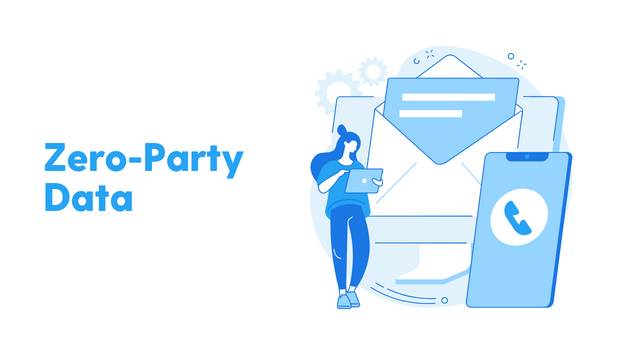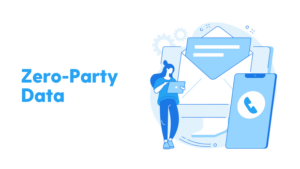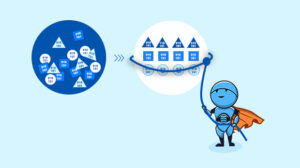Zero party data refers to data that a company collects about its customers through direct and explicit interactions with them, rather than indirectly through observation of their behavior. This can include information that customers actively provide to the company, such as preferences, demographics, and contact information, as well as data generated by these interactions, such as purchase history and feedback.
Zero party data (along with first party data) is valuable to companies because it is directly and explicitly provided by the customer, and therefore tends to be more accurate and relevant than data collected through other means. It can be used to personalize and improve customer experiences, as well as to inform marketing and product development efforts.
How to Collect Zero Party Data
There are several ways that companies can collect zero party data from their customers:
- Analyzing customer behavior: Companies can track and analyze their customers’ actions and behaviors on their websites or mobile apps to infer information about their interests and preferences. This can be done through the use of tracking pixels, cookies, or other technologies. Also, read – Customer Data Platform
- Surveys and questionnaires: Companies can ask customers to provide specific information about themselves, such as their preferences, demographics, and contact information, through surveys and questionnaires.
- Registration and profile creation: Customers can be asked to create profiles or accounts with the company, which may require them to provide certain information about themselves.
- Contests and promotions: Companies can collect zero party data by offering contests or promotions that require customers to provide information about themselves in order to enter or participate.
- Customer service interactions: Companies can collect zero party data through interactions with customers through customer service channels, such as phone or email support.
- Collecting data through opt-in forms: Companies can use opt-in forms on their websites or mobile apps to collect information about their customers’ interests and preferences. This can include things like email newsletters, product recommendations, or special offers.
- Leveraging social media: Social media platforms can be a rich source of Zero Party Data, as they allow companies to see what their customers are saying and interacting with online. This can help companies to better understand their customers’ interests and preferences, and tailor their marketing efforts accordingly.
It is important for companies to be transparent about their data collection practices and to obtain explicit consent from customers before collecting any zero party data. Companies should also provide customers with clear information about how their data will be used and ensure that it is protected and secure.
Also, read:
Zero Party Data vs 1st, 2nd and 3rd Party Data
Zero party data is information that is actively and willingly provided by a customer, often in the context of a brand relationship. This type of data is intentionally shared with the brand and can include things like purchase history, preferences, and location. It is called “zero party” data because it is shared directly with the brand, rather than being collected from other sources.
First party data is data that is collected by a brand from its own customers and users. This can include things like website analytics, purchase history, and email marketing data.
Second party data is data that is shared by one company with another company, usually with the intention of creating a mutually beneficial relationship. For example, a company that specializes in collecting and analyzing customer data might share that data with a retailer, in exchange for access to the retailer’s customer base.
Third party data is data that is collected by an entity that is not directly affiliated with the brand or company using the data. This type of data is often collected and sold by data brokers and can include things like demographic information and web browsing history.
How can DTC Brands Leverage Zero Party Data
Direct-to-consumer (DTC) brands can leverage zero party data in several ways to improve the customer experience and drive business growth. Here are a few ideas:
- Personalization: Zero party data can be used to personalize the customer experience and create more relevant and targeted marketing campaigns. For example, a DTC brand could use a customer’s purchase history and preferences to recommend products or send personalized emails. Also, read: Real time analytics
- Customer Segmentation: Zero party data can also be used to segment customers into different groups, based on characteristics like demographics, interests, and behavior. This can help eCommerce brands create more targeted and effective marketing campaigns.
- Product development: Zero party data can provide valuable insights into what customers want and need, which can inform product development and design. For example, a DTC brand might use zero party data to identify trends or gaps in the market and create products that meet those needs.
- Customer service: Zero party data can be used to improve customer service by providing a more complete understanding of individual customers and their needs. For example, a DTC brand might use zero party data to track customer interactions and identify opportunities to provide more personalized support.
Best Practices for Collecting and Using Zero Party Data
Here are a few best practices for collecting and using zero party data:
- Be transparent: Be upfront and clear about the types of data you are collecting and how you will use it. This can help build trust with customers and ensure that they feel comfortable sharing their data with you.
- Obtain explicit consent: Make sure you have explicit consent from customers before collecting their data. This can be in the form of a opt-in or opt-out option.
- Protect data privacy: Make sure to properly secure and protect the data you collect. This includes implementing appropriate safeguards and regularly monitoring for any potential security breaches.
- Use data ethically: Use the data you collect in a way that is ethical and aligned with customer expectations. This includes respecting customer preferences and not using data in ways that might be unexpected or unwanted.
- Regularly review and update policies: Regularly review and update your data collection and use policies to ensure that they are still relevant and in line with industry best practices.
Challenges in Collecting and Using Zero Party Data
There are a few challenges that companies may face when collecting and using zero party data:
- Obtaining explicit consent: It can be difficult to get customers to share their data actively and willingly with a brand, especially if they are not familiar with the company or do not see the value in doing so.
- Limited data volume: Because zero party data is actively and willingly provided by customers, the volume of data collected may be limited compared to data collected from other sources.
- Data accuracy: The accuracy of zero party data may depend on the willingness and ability of customers to provide accurate information.
- Data privacy concerns: Customers may be hesitant to share their data with a brand due to concerns about privacy and the potential misuse of their information.
- Integration with other data sources: Zero party data may need to be integrated with other data sources, such as first or third party data, in order to provide a more complete picture of the customer. This can be a challenge if the data is not consistent or compatible.
Conclusion
Zero party data has become increasingly vital for effective decision-making in today’s digital landscape. To optimize data collection, analysis, and decision-making, it is crucial to establish a modern data stack that effectively leverages the insights gained from zero-party data. Saras Analytics can help you achieve this goal, providing you with the necessary resources to effectively collect and analyze data from touchpoints and utilize it to inform your decision-making processes. By partnering with Saras, you can ensure that your business is well-equipped to leverage zero-party data to its fullest potential, giving you a valuable competitive advantage in your industry.













